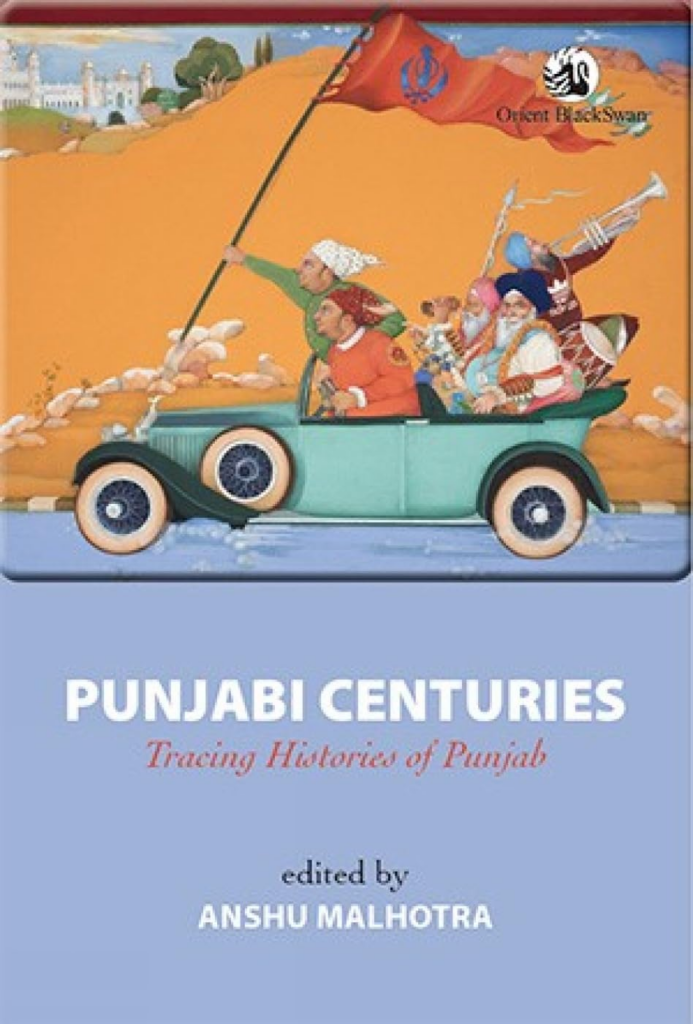
Punjabi Centuries: Tracing Histories of Punjab edited by Anshu Malhotra (published by Orient Blackswan in 2024) traces the complex nature of identity in Punjab, or what it means to be “Punjabi”. Identity, particularly Punjabi identity in this context, is not a static or singular concept but an evolving construct influenced by many factors. This aligns with Benedict Anderson’s notion of nationalism as an “imagined community,” emphasizing that identity, much like nationalism, is layered, multifaceted and ambiguous, constantly changing with time. The book meticulously traces the various socio-political upheavals and cultural exchanges that have impacted Punjab from the nineteenth century to the present day.
The British colonial takeover greatly impacted the development of communal and nationalist identities in Punjab. Under colonial rule, there was a specific coalescing of religion, language, and script: Muslims/Urdu/Shahmukhi; Hindi/Hindu/Devnagari; Sikhs/Punjabi/Gurmukhi. This led to the notion of Punjabi being associated with Sikhism. In the contemporary times, being Punjabi is largely synonymous with Sikh identity. Non-Sikhs who are Punjabi often face questions and doubts about their identity. Although the larger language politics led to Hindi-speaking Haryana in 1961, the Sikh-dominated Punjab still has a substantial Hindu Population of 38.5 per cent according to the 2011 Population Census.
The key strength of the book is its historical background, highlighting different themes that shaped the “Punjabi identity.” The book is divided into ten chapters, the first five focusing on the emergence of print culture and its impact on women’s identity. This section emphasises the transformative power of literacy and print culture in shaping their role. The emergence of print culture allowed women to enter public spheres and also fostered a complex interplay of local traditions and transnational influences. Women, especially those from the upper classes and castes, began using print as a platform for representing their identities and participating in public spheres. New literary forms, particularly reformist literature, emerged from the blending of local traditions and global influences, with gender becoming a central theme. Many male writers addressed social reforms by blending their traditional values with Western literature, while the writings of women became vital for discussing their role in society. However, the actual presence of women in print histories remains limited. In the early 20th century modern Punjabi Literature became a space for exploring new ideas of social reform, though it often remained male-centric and focused on upper class and caste women’s experiences. Dalip Kaur Tiwana remained a significant writer in the post-partition era, alongside writers like Amrita Pritam, unfolding gender issues and patriarchal structures in Punjab, delving into the inner lives and experiences of Punjabi women in small towns. The chapter “Soundscapes of the Self” examines the narratives of two diasporic Punjabi Sikh women in California, highlighting how their efforts build gender solidarities across the boundaries, and how they got an arena for voicing their expressions as they moved abroad.
The Partition of India, one of the greatest tragedies, deeply wounded Punjab. The ongoing tensions in the state have often overlooked the issue of women, especially during the communal and sexual violence of the Partition. The book discusses the case of Rupan Deol Bajaj and KPS Gill during the 1980s Sikh Khalistan movement, raising questions about military security and its impact on women. It argues that nation-building has been a gendered process, where women’s protection is viewed as a matter of patriarchal control rather than actual security and protection.
The following chapters explore the examination of religion, religious policies and caste identity formation and delve into the complexities of social hierarchies and their intersection with personal and collective identity. Modern Sikhism has transformed sacred spaces and pilgrimage practices with new calendars and pilgrimage practices while maintaining the sacred centres in the 20th century. The region’s historical instability demands Pakistan and Khalistan. Sacred shrines are critical domains of religious expression, but dominant Sikh narratives often treat these spaces as extensions of textual discourse labelling deviations as “anomalies”. Events like the Gurudwara Reform Movement, The Partition and the rise of Hindu Nationalism have impacted the significance of shrines. Furthermore, the celebration of Fateh Diwas in 2014, following the success of Shiromani Akali Dal (SAD) raised questions about representing Sikh history and the relationship between figures like Baghel Singh and present-day claims of Sikh Sovereignty. This celebration contrasts with the Khalistan movement, which sought an independent Sikh state, and aligns with the right-wing narratives of Mughal tyranny.
The last chapter book explores the business communities in Punjab, reflecting regional characteristics with specific castes traditionally involved in trade, mostly the Khatri community. Amritsar, founded by Guru Ram Das in 1577, became a hub for traders and merchants, especially during Maharaja Ranjit Singh’s rule. This highlights the intersection of caste, occupation and modernity in shaping the city’s evolution as an urban centre.
The cover of the book very creatively juxtaposes different elements of the Punjabi identity across time. The Mughals holding the flag of Khalsa while riding in a modern car symbolise the historical roots and cultural pride, while the Sikh man in an Adidas sweatshirt reflects the contemporary influences and globalisation. This blend of traditional and modern imagery captures the complexities of Punjabi identity.
Lastly, the association of Punjabi identity with Sikhism, which now appears almost natural, is relatively a recent construct, from the late nineteenth and early twentieth century. It is important to recognise that identity is not natural or inherent but a manmade construct shaped by historical, social, and political influences. During this period, the blending of religion, language and script under colonial rule played a pivotal role, influenced by factors such as migration, colonialism, and socio-political movements. The dynamic nature of identity highlights its fluid and evolving character. This aligns with broader discussions on nationalism and identity, reflecting its complexity.
***
Navpreet Kaur is an undergraduate student at the Thapar School of Liberal Arts and Sciences (TSLAS), Thapar Institute of Engineering and Technology (TIET), Patiala.
